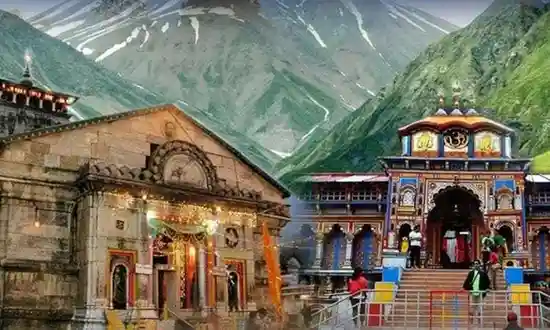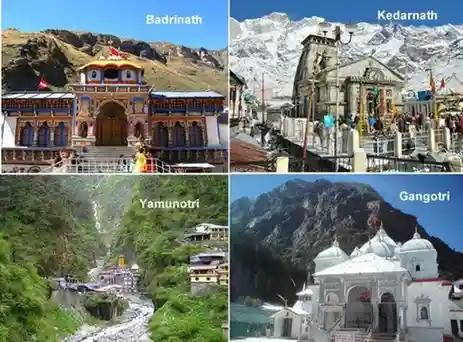Char Dham Yatra Secrets: The Char Dham Yatra is a pilgrimage journey which leads you to the four most revered temples of Yamunotri, Gangotri, Kedarnath, and Badrinath in the Himalayan state of Uttarakhand in India. For many of us, the trip is an once-in-lifetime event—an opportunity to cleanse body and spirit, search for peace from within, and reconnect with ages-old traditions. In this blog, we will reveal secrets and tips to make your Char Dham journey a memorable one. Whether you are a first-time pilgrim or a veteran traveler, these tips will guide you through every step of your journey.
Table of Contents
Grasping the Spiritual Significance: Char Dham Yatra Secrets
It is essential to grasp the profound spiritual significance of the Char Dham Yatra before embarking on your trip.
- Yamunotri: The birthplace of the sacred Yamuna River, which signifies purity and cleansing of evil.
- Gangotri: Abode of the birthplace of the Ganga, which is worshipped as a vitalizing force.
- Kedarnath: A fierce temple for Lord Shiva, which symbolizes change, vigor, and divine power.
- Badrinath: Residence of Lord Vishnu, which signifies protection, conservation, and felicity.
The journey is not just a physical pilgrimage but a spiritual journey that tests you to look inwards, introspect your life, and tap into the divine power of nature and tradition.
Secret 1: Plan Your Journey Well in Advance

Timing is Everything
- The ideal time to undertake the Char Dham Yatra is from April to November.
- Spring (April to June): The hills are lush, and the weather is pleasant. This is a good time to see blooming landscapes and fresh mountain air.
- Autumn (October to November): Clear skies, crisp air, and fewer pilgrims make autumn another ideal time.
- Monsoon and Winter: Monsoon (July to September) may be difficult with heavy rains and slippery roads. Winter (December to March) is not advisable unless you are highly experienced in high-altitude trekking since many roads are likely to be closed due to snow.
Creating a Detailed Itinerary
Map out a day-to-day itinerary with travel times, rest days, and a list of destinations you will visit in what order. Leave space for extra time in case of unforeseen delay due to weather or any other event.
- Begin Early: Wake up early to avoid being in the throngs of tourists and make the most of the serene mornings.
- Rest Days: Have rest and acclimatization days, particularly if you are susceptible to altitude sickness.
Booking in Advance
Accommodation: Make early bookings for your stays. In places such as Kedarnath and Badrinath, where there might be fewer choices, early bookings are necessary. Opt for locations that provide comfort and have a reputation for good food and cleanliness.
- Transportation: Regardless of whether you use private cars, shared buses, or group tours, make your bookings in advance. This minimizes stress and makes your trip easier.
Secret 2: Physically Prepare for the Journey

Get Fit Before You Go
The Char Dham Yatra has long drives, steep roads, and at times difficult trekking. To be able to enjoy the trip to the fullest, it is essential to improve your fitness:
- Cardio Exercises: Walk, run, or cycle to increase stamina. Start a month or two prior to the trip.
- Strength Training: Work on leg exercises and core strengthening. Squats, lunges, and planks can prove to be very useful.
- Trekking Practice: Whenever possible, take a couple of short hikes or treks to acclimatize to walking on rough terrain.
Acclimatize Yourself to High Altitude
Altitude sickness is indeed a possibility on this pilgrimage. If possible, spend a few days at middle altitudes and ease into your journey. Listen to your body and don’t be afraid to rest if you feel any of the symptoms of dizziness, headaches, or nausea.
Secret 3: Pack Smart and Light
Essential Clothing and Gear
Pack apparel according to the unpredictable weather conditions of the Himalayas. Layering is the way to go:
- Base Layers: Wear sweat-wicking clothing to prevent sweat from touching your skin.
- Middle Layers: Fleece or woolen sweaters are good for insulating you.
- Outer Layers: A waterproof coat is a must, particularly if you plan to travel during monsoon season.
- Footwear: Good quality, comfortable trekking shoes should be invested in. Ensure they are well broken-in prior to the trip so that you don’t get blisters.
- Accessories: Scarves, gloves, and hats can be used to adapt to colder temperatures.
Carrying Essentials
- Backpack: Select a light, comfortable backpack. Carry only the bare essentials.
- First Aid Kit: Pack basic medicine, bandages, antiseptics, and any prescribed medications.
- Water and Snacks: Hydration is important; bring a refillable water bottle and energy-giving snacks such as nuts, fruits, and energy bars.
- Navigation Tools: A power bank, additional memory cards for your camera, and a hardcopy map can be your savior during network disruptions.
Secret 4: Respect Local Culture and Environment
Embracing the Pilgrimage Spirit: Char Dham 2025
The Char Dham is not a travel destination per se—it is a spiritual pilgrimage that is rich in local culture and tradition.
- Dress Modestly: Modesty is greatly respected. Dress comfortably in modest attire that respects the sanctity of the places you go.
- Greet Locally: Learn to say simple hellos such as “Namaste” and so on, which can make a big difference in establishing respectful rapport with the people.
- Responsible Behavior: Maintain silence and respect in temple compounds and among pilgrims. Permit yourself to immerse in the spiritual ambiance without distractions.
Nature Care: Chardham
The Himalayas are delicate.
- Dispose of Waste Properly: Bring a small bag to store your trash until you can dispose of it appropriately.
- Stick to Paths: Don’t wander off trails to preserve the local wildlife and vegetation.
- Reduce Plastic Use: Bring reusable items such as water bottles and cloth bags to reduce waste.
Secret 5: Engage with the Local Experience
Connect with Fellow Pilgrims: Char Dham 2025
One of the best-kept secrets of the Char Dham Yatra is the people you meet during the journey.
- Share Stories: Conversing with other pilgrims can offer emotional support and useful insights into the spiritual meaning of the pilgrimage.
- Learn Local Customs: Interacting with locals provides a chance to learn about local traditions, folklore, and the underlying meaning of each holy place.
Try Local Cuisine
The Himalayan region has distinct local flavors.
- Indulge in Local Cuisine: Eat local cuisine like aloo ke gutke, bal mithai, and kachori. This not only makes your experience richer but also enables you to relate to the culture.
- Eat Mindfully: Eat light meals to preserve energy levels and prevent discomfort while walking long distances.
Secret 6: Attitude and Spiritual Preparation: CharDham
Set Your Intentions
Before embarking on the pilgrimage, take a moment to set intentions. Ask yourself:
- What do I expect to learn from this trip?
- What parts of my life do I want to examine?
- How do I embrace the spiritual teachings along the way?
Practice Mindfulness and Meditation
Establish a daily meditation or mindfulness habit to assist in focusing your mind:
- Morning Ritual: Begin your day with a few minutes of meditation or prayer. Concentrate on your breath and release distraction.
- Reflective Journaling: Have a small diary to record your thoughts, experiences, and emotions. You will see your transformation and inner change over time.
Leave Your Worries Behind
The pilgrimage allows you to take a break from the hectic world and reconnect yourself with the sacred.
- Digital Detox: Use mobile phones and gadgets less. Instead, explore the natural landscapes and spirituality.
- Embrace Silence: Appreciate moments of quiet reflection, even if you need to sit by yourself for a few minutes. This silence is healing and powerful.
Secret 7: Capture and Cherish the Moments
Photography and Memories
As much as the pilgrimage is spiritual in nature, taking memories can be helpful in re-experiencing the journey in the future:
- Take Pictures Respectfully: Utilize your camera to take landscape shots, temple architecture shots, and the beauty of nature. Refrain from taking too many selfies.
- Record Your Journey: Keep a digital or written journal, noting your reflections on different stages of the pilgrimage. These memories will serve as a reminder of your growth and the beauty of your spiritual quest.
Collect Souvenirs
Small mementos, such as a pinch of holy water or a decorative token from a temple, can be cherished as reminders of your journey.
- Personal Relics: These can serve as a wonderful addition to your home altar or a memento to share with family and friends.
- Mindful Gifting: Gift these mementos with fellow pilgrims as an offering of goodwill and shared experience.
Secret 8: Learn from Experts and Fellow Pilgrims
Research and Read Stories
Read books, articles, and blogs on Char Dham Yatra before embarking on your trip. Real-life accounts and professional guidance can set your expectations right and prepare you for what lies ahead:
- Books and Articles: Search for travelogues and guides by seasoned pilgrims. They provide practical tips, cautionary experiences, and motivational anecdotes.
- Online Forums: Look for pilgrimage groups or forums and pose questions and share experiences. This collective wisdom is likely to offer tips at the last minute that are not included in common guides.
Seek Professional Guidance
If you are a beginner for high-altitude travel, think of taking an organized tour or hiring a local guide:
- Local Experts: Guides know the terrain very well and can assist you in completing the arduous routes while keeping you safe.
- Organized Tours: These usually incorporate logistical assistance in the form of transportation, accommodation, meals, and required permits. This may relieve you from the anxiety of planning every single detail.
Secret 9: Stay Flexible and Adapt
Prepare for the Unexpected
The Himalayan weather is capricious. Even the best-laid plans can go awry by sudden changes
- Have a Backup Plan: Leave some extra days in your travel schedule in case you need to wait for an improvement in the weather or reschedule your travel.
- Stay Calm: When things go wrong, stay calm and yield. Accept the journey with all its twists and turns—every obstacle is part of your spiritual growth.
Listen to Your Body
Your health is the most important consideration on this pilgrimage:
- Rest When Needed: Don’t be afraid to rest if you’re tired or showing signs of altitude sickness.
- Heed Advice: Pay attention to local guides and other travelers. If they recommend going down to a lower elevation or spending more time acclimatizing, listen to them.
Secret 10: Improve Your Digital Experience (Optional)
Use Technology Wisely
For those who insist on remaining connected during the pilgrimage, technology can actually enrich your experience instead of detracting from it:
- GPS and Maps: Employ offline maps and trekking apps to facilitate navigation of difficult routes safely.
- Digital Diary: Rather than extensive use of social media, try maintaining a digital diary or blog. This aids in recording your journey while being mindful of being present in the moment.
- Be Minimal: Restrict the amount of time you are on your phone. Utilize technology only as required for directions, communication, or taking a few special pictures.
Conclusion: Make It Unforgettable
The Char Dham Yatra is not merely a journey—it’s a transformative experience that cleanses the mind, body, and spirit. With advance planning, preparation, smart packing, and respect for the religious and cultural context of the pilgrimage, you can make your travel experience unforgettable.
Keep in mind these tips:
- Plan in Advance: Decide on the right time, fix your itinerary, and reserve your transport and lodging well in advance.
- Get Physically Prepared: Get fit, concentrate on trekking and altitude adaptation.
- Travel Light: Pack must-haves clothes, equipment, and spiritual necessities and leave excess luggage behind.
- Honor the Culture: Dress appropriately, familiarize yourself with local practices, and be gentle on nature.
- Engage with the Locals: Be friends with fellow travelers and immerse in local taste and customs.
- Condition Your Mind: Get prepared spiritually by meditation, setting goals, and thoughtful note-keeping.
- Document Memories: Capture humble moments through cameras, small tokens of memory, and documentation of the trip.
- Learn and Adapt: Educate yourself via books, forums, and expert advice; stay ready for alterations.
The Char Dham journey is full of obstacles, stunning scenery, and deep moments of introspection and self-improvement. It is a trip that not only pushes your body to its limits but also widens your heart and mind to the miracles of nature and spirituality. Every turn on the curving mountain roads provides an opportunity to reconnect with the divine and bask in the splendor of the Himalayas.
As you embark on this spiritual journey, bear in mind that the pilgrimage is as much a journey of the soul as it is one of arriving at the four sacred destinations. Be receptive to learning, teach others what you know, and allow the natural beauty and spiritual power of the mountains to change you. With the right preparation and mindset, the Char Dham Yatra can become an unforgettable chapter in your life’s story—a time of deep reflection, rejuvenation, and sublime connection to both nature and the divine.
May your journey be safe, your heart open, and your spirit uplifted. Happy pilgrimage!
For more details visit Sharanagatam
Frequently Asked Questions:
1. What is the Char Dham Yatra?
The Char Dham Yatra is a holy pilgrimage to four spiritual temples in Uttarakhand: Yamunotri, Gangotri, Kedarnath, and Badrinath. Each of the locations is rich in spirituality and is said to purify your soul and provide inner peace.
2. When is the optimal time to take the Char Dham Yatra?
The peak season is between April and November. Early spring (April to June) and autumn (October to November) are preferable since the weather is good and the mountain trails are free from snow. Monsoon months (July to September) may be dangerous to travel, and winter (December to March) is usually too cold with most roads closed.
3. How many days should I schedule for the pilgrimage?
Most pilgrims spend 10 to 14 days in the entire trip. That way, you will have sufficient time to travel between the destinations, have acclimatization rest days, and have the spiritual experience without feeling rushed.
4. Do I need to be physically fit for the Char Dham Yatra?
Yes. The trek is on steep, mountainous roads at high elevation. Pre-hiking exercise such as walking, running, or hiking will strengthen your endurance. Strength training, particularly in the legs and core, is also a good idea.
5. What do I need to bring on the pilgrimage?
Travel light but be prepared for unpredictable weather. Bring:
1. Light, layerable clothing
2. A good pair of trekking boots
3. A waterproof coat
4. A compact first-aid kit containing essential medicines
5. A refillable water bottle and a few high-energy snacks
.6. Personal devotional items (such as prayer beads or a little prayer book)
7. A power bank and camera for taking memories
6. What are the travel options to visit the Char Dham?
You have a variety of options depending on your budget and comfort level:
1. Private vehicles: A convenient option for families and groups.
2. Shared buses or shuttles: Less convenient but cheaper.
3. Organized tours: These tours encompass transportation, accommodation, and feeding, as well as a guide to aid in navigating the pilgrimage.
7. How do I prevent altitude sickness during the Yatra?
Acclimatize gradually by spending at least two or three days at a moderate height before embarking on the trek. Hydrate yourself, eat light food, and rest whenever necessary. In case you experience symptoms such as headaches or nausea, slow down or rest until you recover.
8. How crucial is advance planning?
Planning is extremely important. Determine your travel dates, reserve a hotel in advance, and plan your route. A day-by-day itinerary helps you navigate the rest stops and provides additional time for unforeseen delays.

